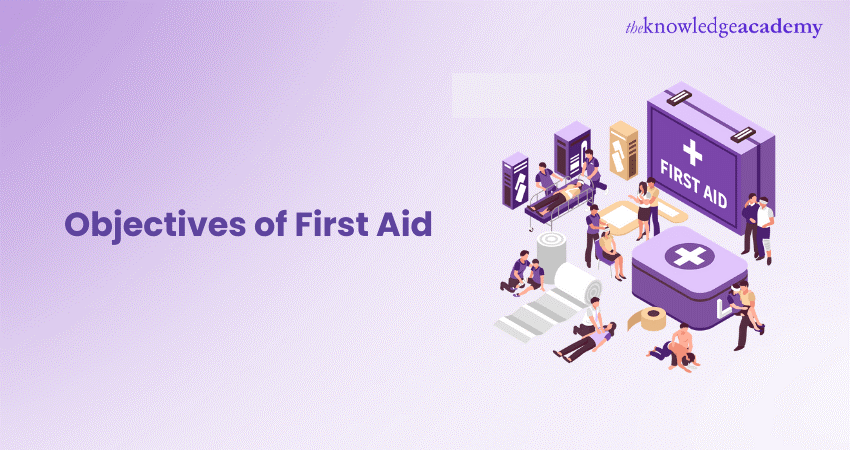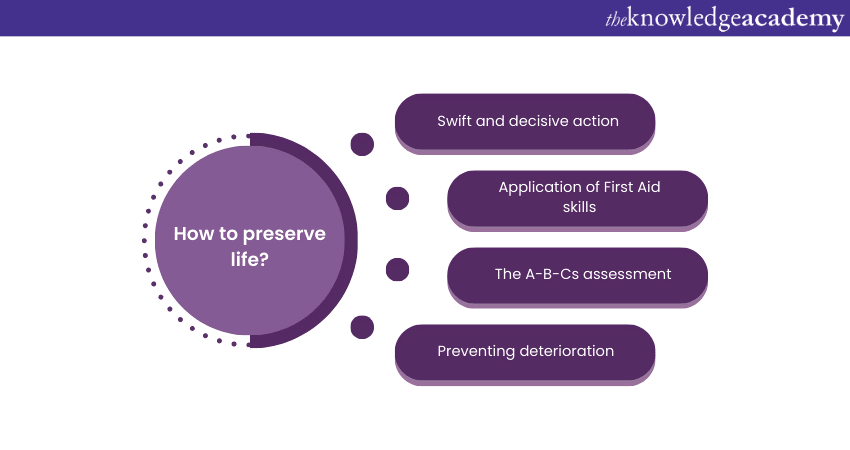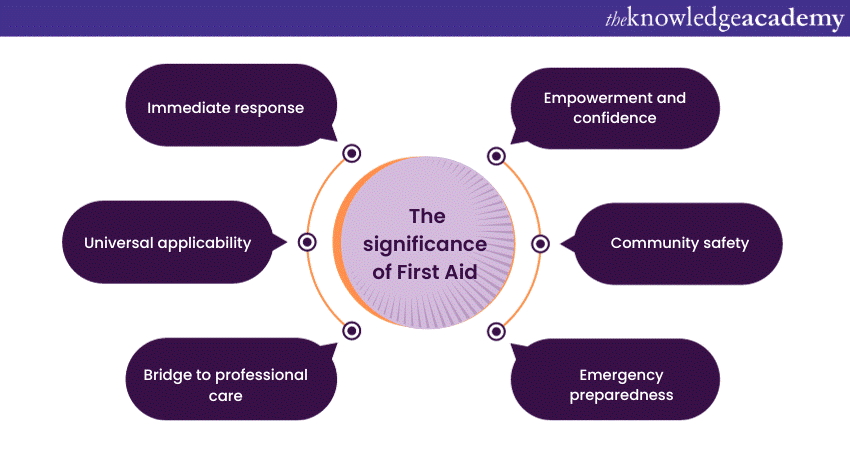We may not have the course you’re looking for. If you enquire or give us a call on 01344203999 and speak to our training experts, we may still be able to help with your training requirements.
Training Outcomes Within Your Budget!
We ensure quality, budget-alignment, and timely delivery by our expert instructors.

Have you ever wondered how immediate care can prevent further injury or even save a life? As a crucial skill, First Aid can make a significant difference in emergencies. But what are the primary Objectives of First Aid? Understanding its objectives is not just for healthcare professionals; it’s a vital knowledge for everyone.
Knowing the right steps to take can be empowering, be it a minor cut or a more serious incident. This blog will discuss the essential goals and principles underpinning effective First Aid practices. Read more to uncover the key Objectives of First Aid and how they can transform your ability to respond in emergencies.
Table of Contents
1) What is First Aid?
2) The Primary Objectives of First Aid
a) Preserve Life
b) Prevent Deterioration
c) Promote Recovery
3) The Significance of First Aid
4) Conclusion
What is First Aid?
First Aid involves offering prompt help to individuals experiencing sudden illness or injury. This intervention aims to sustain life, prevent the situation from deteriorating, and support recovery until professional medical assistance is available.
First aid can include simple techniques like bandaging a wound, performing Cardiopulmonary Resuscitation (CPR), or using an Automated External Defibrillator (AED).
First Aid Training
First Aid training equips individuals with the required skills and knowledge to respond effectively in emergency situations. Through structured courses, participants can learn how to assess situations, provide appropriate care, and use First Aid equipment.
Training often covers a range of scenarios, including treating cuts and burns, managing fractures, and handling cardiac emergencies. By completing First Aid training, individuals become more confident and capable of providing crucial assistance when it matters most.
The Primary Objectives of First Aid
First Aid is an intricate and indispensable discipline which embraces a multifaceted approach. There are three primary objectives upon which the entire First Aid approach exists. They are not just guidelines but also the essence of timely and effective emergency response. These objectives play a pivotal role in determining the outcome of an emergency. They make the difference between life and death, long-term complications and a swift recovery.
1) Preserve Life
In any crisis or emergency, the critical role of a first responder is to act swiftly, decisively, and with the skill to preserve life. This objective includes a spectrum of immediate life-saving actions informed by the knowledge and training acquired through First Aid courses. Let's understand these life-saving actions:

1) Swift and decisive action: The most crucial responsibility of a first responder is to take prompt and decisive action to save lives when confronted with life-threatening situations. This includes having the ability to make quick but informed decisions under pressure. If you have a vehicle nearby, look for an emergency medical kit with the First Aid Symbol.
2) Application of First Aid skills: First responders are equipped with a diverse skill set they acquire during their First Aid training. These skills are put into practice when faced with situations that require immediate intervention.
3) The A-B-Cs assessment: Central to the objective of preserving life is the A-B-Cs assessment. These stand for Airway, Breathing, and Circulation. This assessment is a systematic approach to ensure that the victim's vital life functions function as they should.
4) Preventing deterioration: Preserving life also involves actively preventing the victim's condition from worsening. This requires ongoing assessment and quick adaptation to changing circumstances.
Join our Safeguarding Officer Training and lead the way in creating a secure environment.
2) Prevent deterioration
In emergencies, a first responder's responsibility goes beyond preserving life; it includes preventing further injury or deterioration of the victim's condition. This secondary objective is vital for ensuring the best possible outcome for the victim.
1) Safety Assessment: The first step is conducting a comprehensive safety assessment to identify and mitigate immediate hazards using First Aid. Ensuring a secure environment is crucial before taking any further action.
2) Immediate Stabilisation: Once the scene is deemed safe, immediate stabilisation with First Aid is necessary. This may involve immobilising fractures, controlling bleeding, or supporting dislocated joints. The aim is to minimise the risk of secondary harm and maintain the victim's current condition.
3) Continuous Vigilance: Preventing deterioration is an ongoing process. First responders must continuously monitor the victim's condition, making necessary adjustments using their First Aid skills. This includes regularly assessing vital signs and addressing any changes promptly.
4) Collaboration: In complex cases, collaboration with other first responders or medical professionals may be required to prevent further injury or deterioration effectively. Teamwork ensures comprehensive care for the victim.
Equip yourself with essential First Aid skills – join our First Aid at Work Training and be ready to handle any workplace emergency.
3) Promote Recovery
Beyond preserving life and preventing further injury, the role of a first responder also extends to promoting recovery. This objective focuses on supporting the victim's overall well-being and facilitating a smoother path to healing. Here's how first responders achieve this vital objective:
1) Comfort and Pain Relief: First responders aim to provide comfort and relieve pain. This involves maintaining a warm and comfortable environment for the victim and administering pain relief when necessary.
2) Vital Signs Monitoring: Continuous monitoring of vital signs, such as pulse and respiration rate, is essential. It helps assess the victim's progress and detect any changes in their condition.
3) Emotional Support: Promoting recovery also involves emotional support. A reassuring presence and comforting words can alleviate the stress and anxiety experienced by the victim, contributing to their overall well-being.
4) Assessment of Ongoing Needs: First responders assess the victim's needs and make any necessary adjustments to their care. This includes ensuring their continued comfort and well-being.
This objective highlights the holistic approach of first responders. They address not only the physical aspects of care but also the importance of psychological well-being. By providing comfort, pain relief, emotional support, and ongoing assessment, first responders contribute to a more comfortable recovery process for the victim, reinforcing the pivotal role of First Aid in safeguarding human life and well-being.
Learn how to handle workplace incidents effectively with our First Aid Requirements and RIDDOR Training – join us now!
The Significance of Fundamental First Aid
First Aid plays a crucial role in safeguarding lives and well-being. It is the first line of defence in emergencies and a vital foundation for more advanced medical care. Let's explore the Importance of First Aid:

1) Immediate response: When accidents, injuries, or medical crises occur, quick First Aid response can prevent further harm or complications, even saving lives.
2) Universal applicability: Its principles are universally applicable. Anyone can become a first responder at home, work, or in public spaces. First Aid is a skill that transcends boundaries and empowers individuals to act in critical situations.
3) Bridge to professional care: First Aid often serves as a bridge to more advanced medical care. It stabilises the victim's condition and ensures they have the best possible chances of a positive outcome when professional help arrives.
4) Empowerment and confidence: Learning the main Objectives of First Aid not only equips individuals with life-saving skills but also boosts their confidence. It empowers them to take immediate action and make a real difference in emergencies.
5) Community safety: Communities prioritising First Aid learning objectives are safer places to live and work. It fosters a culture of care where individuals look out for each other and are prepared to respond in times of need.
6) Emergency preparedness: First Aid is an integral component of emergency preparedness. It ensures that individuals and organisations are ready to address unexpected situations, from natural disasters to accidents.
First Aid is a cornerstone of emergency response, offering immediate care, empowerment, and a safer, more prepared society. It underscores the significance of equipping individuals with the knowledge and skills to act swiftly and effectively in times of crisis.
Conclusion
We hope that you understood the Objectives of First Aid from this blog. These objectives empower individuals and enhance community safety. It is also a universally vital aspect of emergency preparedness and overall well-being. So, let’s learn it effectively and save lives!
Equip your employees with essential Health and Safety knowledge – join our Health &Safety in the Workplace Training now!
Frequently Asked Questions

First Aid training gives individuals the ability to swiftly evaluate situations, deliver crucial care, and stabilise patients until professional medical assistance is available. This training fosters confidence, potentially saving lives and reducing the severity of injuries.

A First Aid Provider should possess knowledge of Cardiopulmonary Resuscitation (CPR), wound care, fracture management, and so on. Essential skills include clear communication, quick decision-making, and the potential to stay calm under pressure, ensuring efficient and effective emergency response.

The Knowledge Academy takes global learning to new heights, offering over 30,000 online courses across 490+ locations in 220 countries. This expansive reach ensures accessibility and convenience for learners worldwide.
Alongside our diverse Online Course Catalogue, encompassing 17 major categories, we go the extra mile by providing a plethora of free educational Online Resources like News updates, Blogs, videos, webinars, and interview questions. Tailoring learning experiences further, professionals can maximise value with customisable Course Bundles of TKA.

The Knowledge Academy’s Knowledge Pass, a prepaid voucher, adds another layer of flexibility, allowing course bookings over a 12-month period. Join us on a journey where education knows no bounds.

The Knowledge Academy offers various Food Hygiene and Safety Trainings, including the Food Safety and Hygiene Course, Food Allergy Awareness Training, and Food Plant Sanitation Training. These courses cater to different skill levels, providing comprehensive insights into Nutritionist Salary.
Our Health and Safety Blogs cover a range of topics related to First Aid, offering valuable resources, best practices, and industry insights. Whether you are a beginner or looking to advance your Health & Safety knowledge, The Knowledge Academy's diverse courses and informative blogs have got you covered.
Upcoming Health & Safety Resources Batches & Dates
Date
 First Aid at Work
First Aid at Work
Thu 15th Aug 2024
Thu 12th Dec 2024
Thu 20th Feb 2025
Thu 26th Jun 2025
Thu 25th Sep 2025
Thu 20th Nov 2025







 Top Rated Course
Top Rated Course



 If you wish to make any changes to your course, please
If you wish to make any changes to your course, please


